When it comes to boating in the Great Lakes, ensuring your vessel is well-prepared for the unique freshwater conditions is crucial. One of the most important steps in boat maintenance is applying the right bottom paint, which helps prevent corrosion, fouling, and the buildup of algae, barnacles, and other marine growths on your boat’s hull.
We’ll explore the best bottom paints for Great Lakes boating, taking into account the specific conditions that vessels face in freshwater environments, and provide you with everything you need to know to protect your boat.
Why is Bottom Paint Necessary for Boats on the Great Lakes?
Bottom paint serves as a protective layer for your boat’s hull. While the Great Lakes are freshwater bodies, they still present specific challenges that make bottom paint essential for maintaining the integrity of your boat. Here’s why bottom paint is crucial for vessels in the Great Lakes:
- Prevents Fouling: Even though the Great Lakes are freshwater, they can still harbor algae, slime, and a variety of small organisms that can attach to your boat’s hull. Over time, this buildup can slow down your boat, increase fuel consumption, and even damage the hull. Bottom paint helps to prevent these organisms from adhering to your boat.
- Protects the Hull from Corrosion: Freshwater, while less corrosive than saltwater, still has the potential to cause corrosion, especially if your boat is exposed to frequent changes in water chemistry. Bottom paints, particularly those that contain copper or biocides, help to protect the hull from corrosion by creating a barrier between the water and the hull.
- Improves Performance: A clean, smooth bottom reduces drag, making your boat more efficient. When marine growth accumulates, it increases friction in the water, which can slow your boat down and lead to higher fuel costs. Bottom paint minimizes this buildup and improves overall performance.
- Maintains Aesthetic Appeal: Just like any other part of your boat, the bottom should look clean and polished. Accumulation of organic growth and grime can make the boat appear old and poorly maintained. Regular application of bottom paint ensures that your boat looks great both in and out of the water.
Choosing the Right Bottom Paint for the Great Lakes
When choosing bottom paint for the Great Lakes, it’s important to select a paint designed specifically for freshwater use. Freshwater paint formulas differ from those used for saltwater, as they are engineered to work effectively in lakes and reservoirs. Here are some factors to consider:
- Water Type: Since you’ll be boating in freshwater, choose bottom paints that are labeled as freshwater-specific or suitable for both freshwater and saltwater use.
- Type of Boat: Consider the type of boat you have (e.g., sailboat, motorboat, fishing boat) as some bottom paints are designed specifically for certain boat types.
- Environmental Impact: Choose paints that are environmentally friendly, especially if you’re concerned about protecting the ecosystem in the Great Lakes.
- Durability: Great Lakes boating can involve extended exposure to varying water temperatures, so choosing a durable paint that can withstand the elements is key.
Now, let’s look at some of the best bottom paints for Great Lakes boating, taking into consideration all of these factors.
Best Bottom Paints for Great Lakes Boating
1. Interlux Interprotect 2000E Epoxy Primer
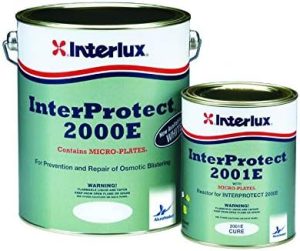
Best for Durability and Protection
Overview: Interlux Interprotect 2000E is an epoxy primer that offers excellent protection against corrosion and damage. It is an effective choice for freshwater environments like the Great Lakes, providing a solid foundation before applying antifouling paint.
Key Features:
- Excellent barrier coating that prevents water penetration.
- Easy to apply and can be used as a primer before applying antifouling paint.
- Offers long-lasting protection in both freshwater and saltwater conditions.
- High build and easy sanding for a smooth finish.
Why It’s Great for Great Lakes Boating: Interlux Interprotect 2000E is an excellent primer that helps prevent damage to your boat’s hull. It offers a reliable base coat that protects the boat from corrosion and ensures that the antifouling paint adheres properly.
2. Pettit Hydrocoat SR
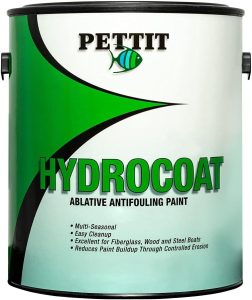
Best for Eco-Friendly Performance
Overview: Pettit Hydrocoat SR is a water-based, environmentally friendly bottom paint that works well for freshwater lakes like the Great Lakes. It’s a multi-season, self-polishing paint that’s designed to reduce the buildup of algae, slime, and other marine growth.
Key Features:
- Self-polishing formula that releases biocides gradually.
- Made with environmentally friendly ingredients that are safe for aquatic life.
- Can be applied directly to clean, dry hulls.
- Provides excellent protection for both fiberglass and wooden boats.
Why It’s Great for Great Lakes Boating: The eco-friendly properties of Pettit Hydrocoat SR make it an ideal choice for environmentally conscious boaters in the Great Lakes. Its self-polishing formula helps ensure long-lasting protection, while the water-based nature makes it less harmful to the environment compared to other paints.
3. Sea Hawk Sharkskin
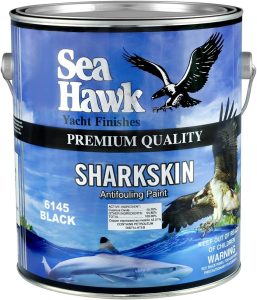
Best for Freshwater and Light Saltwater Use
Overview: Sea Hawk Sharkskin is a versatile, high-performance bottom paint that is excellent for freshwater use, including the Great Lakes. It is formulated to provide a tough, durable finish that resists fouling and algae growth while reducing the need for frequent maintenance.
Key Features:
- Biocide-free formula, making it safer for freshwater ecosystems.
- Self-polishing paint that gradually wears away, reducing buildup.
- Protects against algae, slime, and other fouling agents.
- Available in various colors for aesthetic purposes.
Why It’s Great for Great Lakes Boating: Sea Hawk Sharkskin is perfect for boaters who want a low-maintenance bottom paint that protects the hull from algae and organic growth without harming the environment. Its self-polishing nature ensures long-term effectiveness without frequent reapplication.
4. TotalBoat Aluminum Boat Bottom Paint
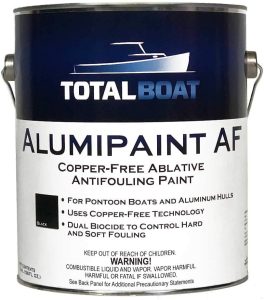
Best for Aluminum Boats in Freshwater
Overview: If you’re boating in the Great Lakes with an aluminum boat, TotalBoat Aluminum Boat Bottom Paint is a top choice. It’s designed specifically for aluminum hulls, which are more vulnerable to corrosion than other materials.
Key Features:
- Prevents corrosion on aluminum hulls, a common concern in freshwater environments.
- Easy to apply and clean.
- Works well in both freshwater and brackish water conditions.
- Available in multiple colors.
Why It’s Great for Great Lakes Boating: This paint is specially formulated for aluminum boats, which are popular in the Great Lakes for fishing and recreational boating. Its corrosion-resistant formula is ideal for fresh water, ensuring that your boat stays protected even in harsh conditions.
5. Interlux Micron CSC
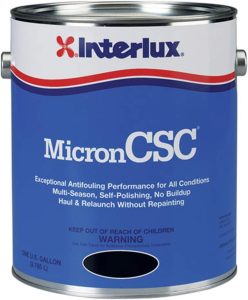
Best for Multi-Season Protection
Overview: Interlux Micron CSC is an advanced, multi-season bottom paint that works well for both freshwater and saltwater environments. It’s designed to provide long-term protection for boat hulls, preventing fouling and promoting smooth, efficient sailing.
Key Features:
- Copper-based antifouling paint.
- Provides long-lasting protection against marine growth.
- Available in a range of colors and is highly durable.
- Excellent resistance to the buildup of slime and algae.
Why It’s Great for Great Lakes Boating: Interlux Micron CSC is ideal for boaters who want a high-performance bottom paint that provides multi-season protection. Its copper-based formula is effective against fouling, while the paint ensures that your boat’s bottom remains clean and smooth for longer periods.
What to Consider When Selecting Bottom Paint for the Great Lakes
When shopping for bottom paint for your boat, there are several important factors to keep in mind to ensure you’re getting the best protection for your vessel:
- Freshwater Compatibility: Make sure the paint you choose is designed for freshwater use. Freshwater paint formulas are different from those made for saltwater, and they are specifically designed to address the unique challenges of freshwater environments.
- Eco-Friendliness: The Great Lakes ecosystem is delicate, and boaters should be mindful of their environmental impact. Look for bottom paints that are free of harmful chemicals like copper and biocides, especially if you’re concerned about protecting the aquatic life in the lakes.
- Durability: Freshwater conditions can be just as harsh as saltwater, especially in cold temperatures, so selecting a paint that offers long-lasting durability is crucial. The right bottom paint will protect your hull for an entire season or longer.
- Type of Boat: The material and size of your boat will also influence the type of bottom paint you choose. Aluminum boats require specialized bottom paint, while fiberglass boats may need different formulations. Make sure the paint is suitable for your boat’s construction.
- Ease of Application: Some bottom paints are easier to apply than others, so consider how much time and effort you’re willing to spend on the application process. Some paints require special priming or sanding, while others can be applied directly to the hull.
Conclusion
Choosing the best bottom paint for your boat in the Great Lakes is essential for preserving its performance, protecting it from corrosion and fouling, and maintaining its aesthetic appeal. Whether you’re looking for eco-friendly options, a paint suitable for aluminum boats, or a durable, long-lasting formula, there are many great choices available to meet your needs. Always consider the type of boat you have, the environmental impact of the paint, and the durability of the product when making your decision.
By selecting the right bottom paint, you’ll ensure your boat is ready to take on the unique challenges of boating in the Great Lakes, all while keeping your vessel in excellent condition season after season.


Leave a Reply